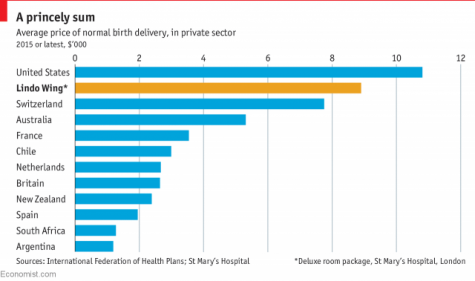Costly Care

Rena Long’s husband was diagnosed with Leukemia last year, and the cost to treat adult Leukemia can be extremely high.
The typical child born into the British Royal Family will cost around £5,670, or $8,900, according to The Economist, a newspaper devoted to analyzing economics. The article goes on to state that, in the United States, the cost of delivering a baby is over $10,000. This places the 8.5% of Americans that are uninsured in extreme debt, having to pay this $10,000 either from their savings or through loans. These staggering costs are what come with many modern medical procedures, and this leads to a dilemma – pay thousands of dollars or find another solution?

According to CNBC, 137.1 million Americans struggled with medical debt in 2019, and the fact that nearly ⅓ of Americans suffer with this has given rise to a new trend to try to prevent people from going into debt – going to another country to get medical procedures, The most common being dental, heart, and cosmetic surgeries, which can be far cheaper than if done in the United States, a method dubbed by the Centers for Disease Control and Prevention as “Medical Tourism”.
Medical Tourism, according to the CDC, presents several risks for patients, including communication problems in hospitals that speak a different language, counterfeit medications, infections, blood clots after air travel, and even illegal organ trafficking. However, these risks are worth it to the 20% of the outbound travel tourism market consisting of U.S. Citizens. Ivonne Want, Spanish teacher at Lake Ridge, used to live near the border of the U.S. and Mexico. She had multiple medical procedures done both in Mexico and in the U.S.. Want claims that, while dealing with border security was a hassle, the treatment was comparable to the United States, and, despite the CDC’s warnings, there were no complications.
“It’s definitely a lot cheaper to get things done in Mexico. I used to live 20 or 30 minutes from the border, so it was relatively easy for me to get medical procedures like root canals and checkups down in Mexico. Just for comparison, a dental procedure in the U.S. could be around $800 and $1000, it would be around $70 or $80 there. The treatment wasn’t much different than it is here, but being able to speak Spanish definitely helped for communication,” said Want.
Reasons for going out-of-country for medical tourism include cheaper procedures, care quality, and experimental treatments, according to Employee Benefit News. The economic hardship that can follow surprise medical fees, such as Emergency Room visits, can be one of the largest drivers of Medical Tourism, and according to the Journal of American Medical Associates, or J.A.M.A., health care costs in the U.S. are steadily increasing, driving more and more people beyond America to seek help.
“Spending on health care in the United States is higher than in any other country and is increasing. According to official US records, total health spending in 2015 reached $3.2 trillion and constituted 17.8% of the US economy. Even after adjusting for inflation, the annualized growth rate in US health care spending between 1995 and 2015 was 4.0%. This growth is in excess of the rate of growth of the total US economy, which was 2.4% during this period,” said the J.A.M.A. report.
The sheer cost of health care in the United States is indiscriminate – whether you have a cold or a life-threatening illness. Such is the case of Rena Long, AP World History teacher at Lake Ridge. Her husband was recently diagnosed with Leukemia, a type of cancer that effects the blood. He is currently undergoing treatment at the T Boone Pickens Cancer Center in Dallas, and has recently received a stem cell transplant. Long claims that her insurance has covered most of the costs, however, she had a $1,500 deductible which she had to pay herself.
“We are very fortunate that we have really good insurance. We have reached the max out-of-pocket for my husband, so we no longer have to pay any more, but our deductible is $1,500. So we had to pay that deductible before we hit max out-of-pocket. It was around $100,000 for the stem cell transplant, and then the anti-rejection drugs are $50,000,” said Long.
The issue of medical costs go beyond the hospital – it can go as far as your pharmacy’s shelves. Drug Companies continuously raise prices for their medications, claiming that drug prices rise as the companies continue to innovate and improve their medicine. However, according to a study by Health Affairs, a medical journal, the price increases are not due to innovation, rather it’s due to manufacturer price increases.
One popular case of this is when Martin Shkreli, former Chief Executive of the pharmaceutical firm Turing Pharmaceuticals, now known and Phoenixus AG, raised the price of the drug Daraprim, which is used to treat AIDS, Malaria, and Cancer, from $13.50 to $750 per pill – that’s nearly 5,000%. This earned him the nickname “Pharma Bro” and gave him infamy throughout the U.S.. When he was criticized by the media and the public, he defended himself in saying that the drug is worth the cost in order to save lives.
“We’re the first company that really focused on this product. And I think that’s a great thing, because ultimately companies before us were actually just giving it away, almost. The price that they were pricing it at, $13.50, you only needed less than 100 pills, so at the end of the day the price per course of treatment to save your life was only $1,000,” Shkreli said to Bloomberg in a 2015 interview.
From emergency room visits to dentist appointments, the healthcare crisis has brought many families to financial strife. Health insurance is the most reliable way to alleviate these costs, but affordable healthcare is coming under fire. One of President Donald Trump’s campaign promises was to repeal Obamacare, which provides affordable healthcare to 8.5 million Americans, according to Reuters. While he has been largely unsuccessful in repealing the Obama-era policy, he has managed to repeal the penalty upon people who might afford health insurance, but choose not to buy it, as well as remove taxes on the rich and large businesses that help pay for Obamacare.
While the country still scrambles to figure out whether they want to make health care affordable or not, people like Rena Long will have to rely completely on health insurance – or go into extreme debt to save her husband’s life. As costs continuously spiral upwards, this highlights a very important question: how much would you pay to live?


